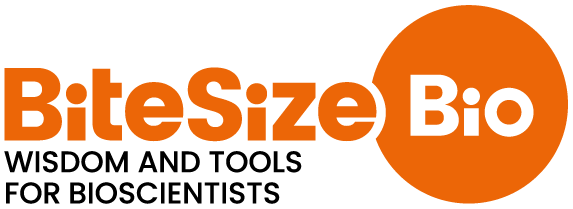All Episodes
Displaying 91 - 115 of 115 in total
The Basics: How Phenol Extraction of DNA Works
#25 — Phenol extraction of DNA is a commonly used method for removing proteins from nucleic acids, for example, to remove proteins from cell lysate during genomic DNA ...

Postdoc Interview Preparation: Sample Questions and Answers
#24 — How can you best prepare for a postdoc interview? Here we cover 10 questions that are often encountered during the job-hunting process. Preparing answers to the...

Creativity in Science: How a Good Imagination Can Help Your Research
#23 — Creativity in Science: How a Good Imagination Can Help Your ResearchIf you're stuck in a research rut in the lab, developing your creativity can help you find n...

Ten Bad Chemicals in the Lab and What They do to You!
#22 — Research often requires you to use dangerous chemicals. From caustic acids and bases to pH solutions and toxic reducing agents, chemical hazards abound in the la...

How Confluent Are Your Cells? A Beginner’s Guide to Measuring Cell Culture Confluency
#21 — Do you know the difference between cell confluency and cell number? Can you measure cell confluency accurately? Cell confluency measurements are essential in cel...

Laemmli Buffer: What Is It for Anyway?
#20— Have you ever wondered how Laemmli buffer actually works? In this episode of Mentors At Your Benchside, we talk through the different components of Laemmli buffer...

What is Alternative Splicing, and Why Is It Important?
#19 — Listen to this episode to discover what alternative splicing is, the history of how it was discovered, and get key examples of splicing in action.Read the full a...

Why Is SDS-PAGE Run Vertically? Here are 3 Great Answers
#18 — Why are SDS-PAGE gels run vertically? What would happen if we ran them horizontally? Has anyone ever tried? Discover the answers to these questions and more in t...

How (and Why) To Manipulate Plasmid Copy Number
#17 — Why do some plasmids give a better protein yield than others? It may have a lot to do with the plasmid copy number. In this episode we talk about what plasmid co...

Top 10 Tips for Viva Success
#16 — Is your viva on the horizon? Many people think viva exams are going to be painful. But what if you could make your viva go smoothly and maybe even enjoy it? List...

A Brief History of CRISPR-Cas9 Genome-Editing Tools
#15 — In the last few years, CRISPR-Cas9 has become a popular genome editing tool, but have you ever wondered where it came from? In this episode we explore the histor...

How to Measure and Improve Lab Accuracy and Precision
#14 — Do you know how accurate and precise your measurements are? Imprecise and inaccurate measurements can have a dramatic impact on your results. Listen to get 8 top...

The Ultimate Guide to Choosing a Fluorescent Protein
#13 — There are now hundreds of different tailored fluorescent proteins to choose from that can improve your experiments in the lab.What are the key considerations whe...

DNA Precipitation: Ethanol vs. Isopropanol
#12 — As a follow-up to our episode about ethanol precipitation of DNA and RNA [1], this episode explains the differences between DNA precipitation in ethanol and isop...

How Fluorescent Molecules Work: Shine Bright like a Diamond
#11 — Fluorescence is undoubtedly one of the most important and useful tools in a biologist’s toolbox. But do you actually know how fluorescence works? In this episode...

Which Type of Ethanol Should I Use?
#10 — As you probably know, there are different types of ethanol found in biology labs. It's a versatile solvent used in dozens of experiments and procedures, includin...

What the HEK? A Beginner’s Guide to HEK293 Cells
#9 — One of the most commonly used cell lines in molecular biology labs is the Human Embryonic Kidney HEK293 cell line. Listen to this episode to find out all about th...

How SDS-PAGE Works
#8 — You probably have or will use SDS-PAGE at some point to separate proteins, but do you really understand how this technique works? Knowing how SDS-PAGE works means...

How a Jellyfish Changed Biology: the Discovery and Development of GFP
#7 — In this episode, we cover how jellyfish were able to have a huge impact on biology through the discovery and development of GFP.Using GFP is now ubiquitous in pre...

Ethanol Precipitation of DNA and RNA: How it Works
#6 — Ethanol precipitation is a commonly used technique for concentrating and de-salting nucleic acid preparations in an aqueous solution.In this episode, we'll bring ...

20 Telling Signs You're a Scientist
#5 — Have you ever chilled beer on dry ice from the lab? Does your wardrobe consist mainly of free t-shirts from companies at conferences [1]? Have you ever wondered w...

What is PCR? The Beginner’s Guide
#4 — PCR is a useful lab technique used to copy, sequence or quantify DNA. If you're new to PCR, this episode is for you. We cover the five things you need to get star...

A Short History of Cryo-Electron Microscopy
#3 — In this episode of Mentors At Your Benchside, listen to a short history of cryo-electron microscopy—the Nobel Prize-winning technique revolutionizing molecular an...

17 Ways to Stop Pipetting Errors From Ruining Your Experiments
#2 — Micropipettes are the bread and butter instrument of a lab, helping you to accurately dispense minute amounts of liquid. But these tools are only trustworthy if t...

Is it Worth Doing a PhD After a Master’s?
#1 — Is it worth doing a PhD? This is a question that probably plagues every research student at some point in their career.In this episode, we explore 5 important que...


